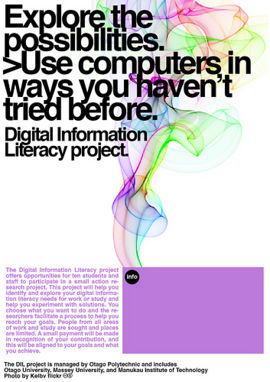
Yesterday I attended the second workshop of the
Digital Information Literacy Research Project that I am taking part in.
Showing my blog
We were asked to expand on the thinking we had done on what our goals are for the project.
My goals are to become familiar with
Camstudio so that I can make 'how to' screencasts. I also want to become familiar with making and editing video. I have been documenting my thoughts and actions here on this blog and even had a 'play' with
Animoto over the weekend.
I decided that I wasn't going to say anything because I tend to be very vocal at the best of times, and I didn't want to hog proceedings. But my good intentions came to naught, but it wasn't my fault...honest!
I was asked to show the group my blog and explain how I use it to document my thinking, actions and reflections. So I showed the group my posts, how I responded to comments and explained how feedback from the wider blogging community has led to interactions and further actions eg
my conversations with Kate Foy led to me making an Animoto video to put in my
ePortfolio.
Enjoying the limelightI never have any problem talking to people, especially if it is about myself and something I am passionate about. But I wasn't too sure what exactly was required of me, so I felt I jumped around a lot from one blogging issue to another in no particular logical sequence. Talking about blogging is a huge topic and not one I could do justice to in a couple of minutes. The Animoto video didn't show up very well because of the classroom lighting. This was a tad disconcerting because I had been raving on about how good it was.
But it was very interesting to see what issues emerged in just that short period of time.
Privacy I have no qualms about publishing my personal thoughts and details of my personal and professional life. My children are now adults so I do not publish any more information than they do on their Facebook and Bebo accounts. I always try to behave in a professional way (although I do have the odd slip) but I would never do anything like publish my bank account details.
I feel that I am claiming my online identity and taking control of my online presence. By setting up a strong
online 'brand' I have a much better chance of setting people up to see what I want them to see, as opposed to having no control of what people see about me.
TimeYes, I do spend a lot of time online - writing, thinking, reading, talking, strategising, developing, innovating & networking. But this is my deliberate choice - I do this rather than sit around watching TV (although I never, never miss 'Top Gear' and 'America's got talent'). I do not see it as a waste of time because it is
my way of learning and it has had academic outcomes already eg I have had one conference paper and a book chapter accepted within the space of 9 months, based on my online experiences and learning.
Open access
By telling my stories and reflecting online in an open environment, I am opening myself up to an international audience which hugely increases opportunities for peer review, collaboration and learning.
What I got out of the session
I didn't 'learn' anything as such but the session did make me realise how much I have learned in the last few months and how far I have progressed with the development of my own digital literacy skills, which is very pleasing.
At the same time, it also emphasized how important it is that I do not make assumptions about other people's digital literacy skills. Most people are not at the same stage as me, so I must be very careful to give information about using the Internet at a level that people can understand. And I must accept when people do not embrace the Internet with the same 'obsessive' fervor as I do.
Image: 'reach' sadaiche
www.flickr.com/photos/92252681@N00/1550847304
 For the Comment Challenge today, I have to make a recommendation about a resource in a comment.
For the Comment Challenge today, I have to make a recommendation about a resource in a comment.






















